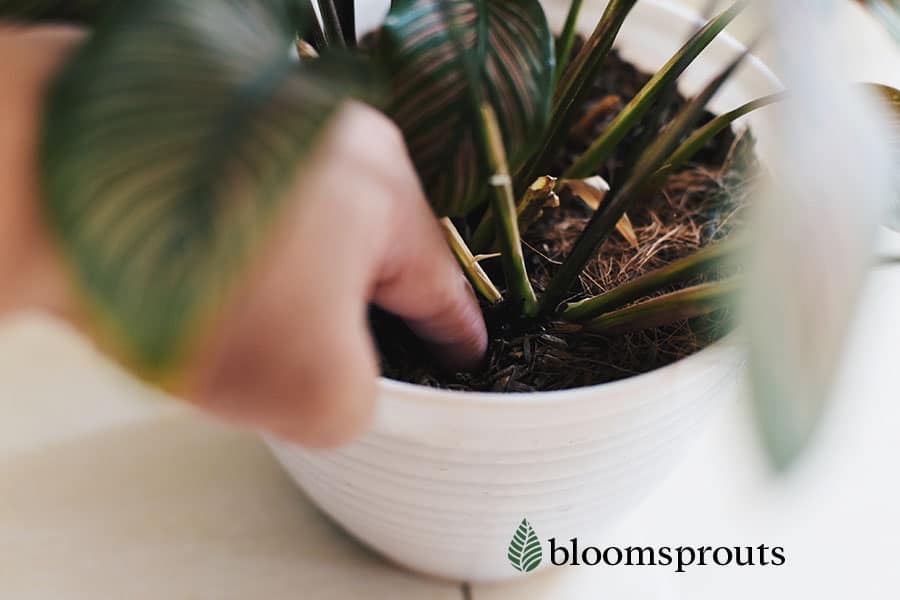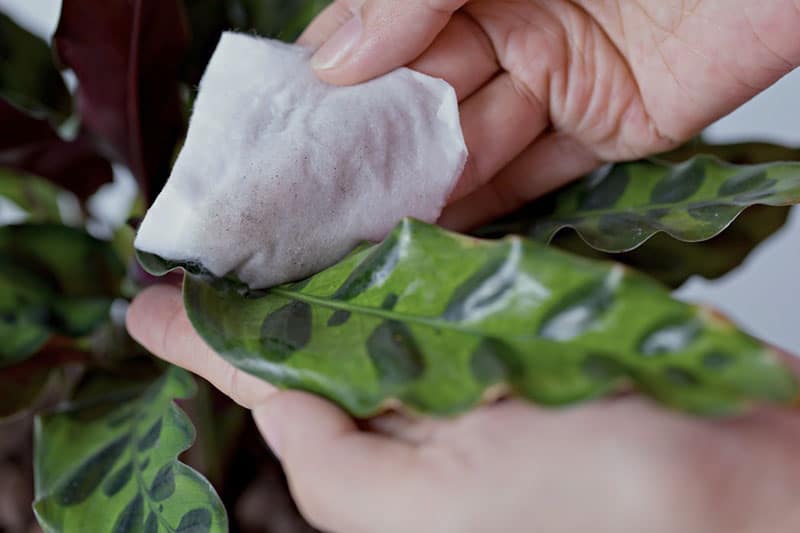
Do you find your Calathea plant drooping? What can possibly be wrong with it?
Generally, Calathea plants droop when they’re dehydrated. Several causes, including improper watering, low humidity, and damage to the roots, disrupt the supply of water to the cells that generate turgor pressure to help the plant stay upright.
In this article, we’ll look at various reasons for your Calathea plant’s drooping leaves and how to fix them.
Let’s get started!
Why Calathea Plants Droop?
Water is required for Calathea plants to generate turgor pressure throughout their leaves and stems cells for them to stand upright.
The Prayer plant will droop when the water pressure in a cell is lost, whether through too much moisture loss or because the plant’s roots cannot absorb water fast enough.
Can Calathea Recover from Drooping?
Calathea plants that droop due to underwatering can recover in a few hours after deep watering. However, severe drought may damage plant cells and even lead to wilting.
On the other hand, damage to the roots may result in drooping that takes longer to heal.
Causes of a Droopy Calathea
Now, let’s look at some of the reasons why a Calathea plant’s leaves may droop.
There are six leading causes:
Underwatering
Do you forget when the last time you watered your Calathea was?
If this is the case, there’s a high possibility that the plant is drooping due to underwatering.
The cells in the leaves and stems are dehydrated and start to lose their turgor pressure, which causes the plant to droop.
Interestingly, the drooping also acts as the plants’ survival mechanism to reduce further water loss by decreasing the leaves’ surface area.
How to check if Calathea is underwatered

- Check if the leaves also show curling, crisping, or turning light brown. If so, it may be an indication that the plant has been underwatered.
- Also, check if the soil is dry by sticking your finger into the soil. If your finger comes out clean when you pull it, there’s no longer any moisture in the soil.
- You may also purchase a soil meter if you wish to be more precise. Insert the probe halfway into the pot. If the reading read below 3, then your Calathea needs water.
How to revive underwatered Calatheas
Luckily, underwatered Calathea is an easy fix.
- Soak the soil with plenty of water for a few minutes and allow water to drain out completely. Your Calathea should be back to its old self in a few hours.
- You should also trim away the crispy, dead leaves so that the plant puts more of its energy into growing new leaves instead.
- Also, schedule a regular watering schedule for your Calathea to prevent underwatering from happening again.
Overwatering
Calathea drooping may result from giving it too much water. Overwatering eliminates air pockets in the soil, which prevents the roots from breathing and absorbing enough oxygen.
This will eventually result in root rot, causing the plant to stop absorbing water and nutrients.
When there is not enough water, the cells start to collapse. Eventually, the plant loses its turgidity and droop.
How to check if Calathea is overwatered
- Yellowing and drooping leaves are classic signs that Calathea is overwatered.
- Check to see whether the soil is still wet after two weeks or more since you watered it. This is often an indication that your soil isn’t well-draining, resulting in water to pool.
- Remove your Calathea from its pot and check for root rots. If the roots are soft, mushy, and dark brown/black, your Calathea has been overwatered.
How to fix overwatered Calathea
- Repot your Calathea with a well-draining and aerated potting soil mix. You can also add pine bark or perlite into the potting soil to improve its drainage properties. Check my guide for the best soil mix for Calathea.
- If you identify root rot, you need to cut away the dead roots and treat them with hydrogen peroxide before repotting them in a fresh pot.
- Make sure you have enough drainage holes in your pot.
Low Humidity
Do you remember that water moisture moves from an area of higher to lower moisture content?
When humidity levels are low, Calathea loses more water through its leaves via transpiration. As the roots cannot replace the lost moisture quickly enough, the leaves will start to droop.
How to identify Calathea suffering from low humidity
- Signs of low humidity are often confused with underwatering. This is because both underwatering and low humidity can lead to curling, drooping, browning, or crisping leaves.
- You will need to invest in a hygrometer to determine whether your Calathea suffers from low humidity or drought.
How to improve humidity for Calathea
- Calatheas like humid environments, and placing them in a room with humidity levels above 60% allows them to thrive.
- Purchase a humidifier for your plants and turn it for a few hours every day between sunrise and midday, or when the air feels really dry.
- Try to group your plants together to increase the humidity level around the space.
Also read: Misting Calathea: Does It Improve Humidity?
Rootbound
The roots of your rootbound Calathea will be forced to grow in circle following the shape of the pot.
This will eventually lead to your Calathea roots forming a tight mass and leave no room for soil.
When there is no more space for soil in the pot, your Calathea will stop absorbing water and nutrients. Instead, the leaves will droop from lack of hydration.
How to identify rootbound Calathea
- Signs of underwatering, including drooping and curling leaves, are common in a rootbound Calathea.
- Stunted growth is another common sign.
- Roots may extrude out of the drainage holes and the soil surface as there is no more room for the roots to grow.
- To confirm rootbound, you need to remove the entire plant from its pot. The roots will look like a solid pot of roots, indicating that your Calathea has been rootbound for too long.
How to fix root bound Calathea
- You can simply repot your Calathea with a bigger pot. I always get a pot that is 2 inches wider than the original pot.
- Another way to fix rootbound Calathea is propagating them with the division technique. You may need to divide the roots with a sharp, clean blade or scissors. Make sure each cutting has part of the root system and is attached to a stem.
Repotting Shock
While you are repotting, you can’t avoid damaging the fine roots of the Calathea plant.
If the damage is extensive, it can slow down the absorption of water.
When the roots cannot absorb enough water to replace water loss from transpiration, they will lose turgidity and start to droop.
How to fix transplant shock in Calathea
- Calathea that is in shock, will need proper care and time to adjust to the new environment before growing again.
- Avoid giving the plant fertilizer at this point, as it can burn new root growth.
- Your Calathea will recover from transplant shock in three to four weeks.
Dusty Leaves
According to a study, the accumulation of dust on Calathea leaves can increase the leaves’ temperature and transpiration rate.
As discussed above, when the roots cannot absorb enough water to replace the loss from transpiration, the Calathea plants will start to droop.
How to clean dusty Calathea leaves

- Cleaning your plants’ leaves should be done frequently to prevent dust from accumulating on the leaves. Assign a weekly or bi-weekly schedule to wipe the dust off your plants’ leaves.
- Use damp cloths to wipe both the top and underside of each leaf gently. Make sure to use your palm to hold the opposite side of the leaves to minimize stem injury.
- You can also apply neem oil on the cloth to protect the leaves from potential pest infestation.

